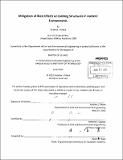| dc.contributor.advisor | Jerome J. Connor. | en_US |
| dc.contributor.author | Maxa, Andrew J | en_US |
| dc.contributor.other | Massachusetts Institute of Technology. Dept. of Civil and Environmental Engineering. | en_US |
| dc.date.accessioned | 2012-10-26T18:11:12Z | |
| dc.date.available | 2012-10-26T18:11:12Z | |
| dc.date.copyright | 2012 | en_US |
| dc.date.issued | 2012 | en_US |
| dc.identifier.uri | http://hdl.handle.net/1721.1/74467 | |
| dc.description | Thesis (S.M.)--Massachusetts Institute of Technology, Dept. of Civil and Environmental Engineering, 2012. | en_US |
| dc.description | Cataloged from PDF version of thesis. | en_US |
| dc.description | Includes bibliographical references (p. 52-53). | en_US |
| dc.description.abstract | Military commanders in austere environments often face challenges in setting up headquarters buildings that offer protected areas for sensitive equipment. One solution to this problem is simply to build a structure that can be used for this purpose. This method can prove to be difficult in that it could either require large amounts of prefabricated concrete, heavy earthmoving equipment, or a significant effort in digging by hand. Clearly, all of these options are unsuitable for constructing a headquarters building that would be occupied for a short time or if the resources required were unavailable. Another solution to this problem is to simply occupy an existing structure. This method is extremely favorable with respect to resources required; with the major drawback being that at times existing structures may offer limited protection from hostile forces. Since the US Army often has overwhelming firepower when compared to contemporary threats, many times hostile forces will resort to suicide or remotely detonated explosive devices when attempting to destroy or damage structures of this type. In order to determine the feasibility of mitigating this threat, this paper will explore the effects of various explosive devices on model building types that may be found in austere environments, and explore the effects of possible reinforcement schemes in mitigating blast threats to these structures. | en_US |
| dc.description.statementofresponsibility | by Andrew J. Maxa. | en_US |
| dc.format.extent | 53 p. | en_US |
| dc.language.iso | eng | en_US |
| dc.publisher | Massachusetts Institute of Technology | en_US |
| dc.rights | M.I.T. theses are protected by
copyright. They may be viewed from this source for any purpose, but
reproduction or distribution in any format is prohibited without written
permission. See provided URL for inquiries about permission. | en_US |
| dc.rights.uri | http://dspace.mit.edu/handle/1721.1/7582 | en_US |
| dc.subject | Civil and Environmental Engineering. | en_US |
| dc.title | Mitigation of blast effects on existing structures in austere environments | en_US |
| dc.type | Thesis | en_US |
| dc.description.degree | S.M. | en_US |
| dc.contributor.department | Massachusetts Institute of Technology. Department of Civil and Environmental Engineering | |
| dc.identifier.oclc | 813830053 | en_US |
